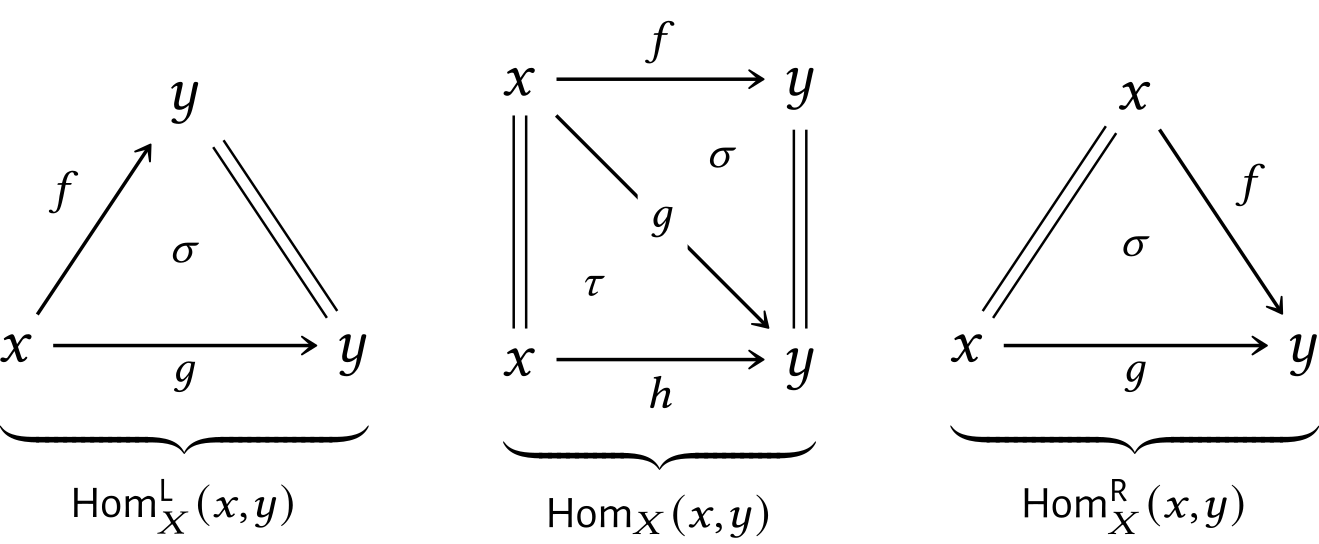$\newcommand{\defeq}{\overset{\mathrm{def}}{=}}\newcommand{\rmR}{\mathrm{R}}\newcommand{\rmL}{\mathrm{L}}\newcommand{\End}{\mathrm{End}}\newcommand{\Hom}{\mathrm{Hom}}$This question is a sequel to my earlier question, Do the various notions of morphism spaces of simplicial sets agree on the underived level?.
Morphism Spaces
Given a simplicial set $X_\bullet$ and 0-simplices $x,y\in X_0$, we have a few different notions of morphism spaces of $X_\bullet$, including in particular the left- and right-pinched morphism spaces \begin{align*} \Hom^{\rmL}_{X}(x,y) &\defeq X_{x/}\times_{X}\{y\},\\ \Hom^{\rmR}_{X}(x,y) &\defeq \{x\}\times_{X}X_{/y} \end{align*} of $X_\bullet$ studied in Kerodon, Tag 01KW, as well as its (non-pinched/two-sided) morphism space $$\Hom_{X}(x,y)\defeq\{x\}\times_{X}\mathrm{Fun}(\Delta^{1},X_\bullet)\times_{X}\{y\}$$ studied in Kerodon, Tag 01J4.
The 0-simplices of these morphism spaces are the 1-simplices of $X_\bullet$ from $x$ to $y$, and their 1-simplices look like this:

We also have comparison maps \begin{align*} \iota^{\rmL}_{x,y} &\colon \Hom^{\rmL}_{X}(x,y) \hookrightarrow \Hom_{X}(x,y),\\ \iota^{\rmR}_{x,y} &\colon \Hom^{\rmR}_{X}(x,y) \hookrightarrow \Hom_{X}(x,y). \end{align*}
Endomorphism Spaces
We may specialise the constructions introduced above to the case $x=y$ to obtain three notions $\Hom^\rmL_X(x,x)$, $\Hom^\rmR_X(x,x)$, and $\Hom_X(x,x)$ of an “endomorphism space $\End_{X}(x)$ of $X_\bullet$ at a point $x$”. In addition to these, we also have the simplicial sets \begin{align*} \End^{\Delta^{1}/\partial\Delta^{1}}_X(x) &\defeq \{x\}\times_{X}\Delta^1/\partial\Delta^1,\\ \End^{\mathbf{B}\mathbb{N}}_X(x) &\defeq \{x\}\times_{X}\mathrm{Fun}(\mathbf{B}\mathbb{N},X), \end{align*} the first of these being introduced in Kerodon, Tag 03X9, with Kerodon, Tag 00JC providing a comparison between $\mathbf{B}\mathbb{N}$ and $\Delta^{1}/\partial\Delta^{1}$.
The Question
Taking the $\pi_0$ of morphism spaces of simplicial sets leads to different notions of homotopies between 1-simplices of simplicial sets. For instance, we might call 1-simplices $f,g\colon x\rightrightarrows y$ left-homotopic in a simplicial set $X_\bullet$ if they lie in the same equivalence class in $\pi_0(\Hom^\rmL_X(x,y))$.
Similarly, we could define notions of right homotopy and two-sided homotopy between 1-simplices, as well as two a priori different notions of homotopies between endomorphisms of $X_\bullet$ using the simplicial sets $\End^{\Delta^{1}/\partial\Delta^{1}}_X(x)$ and $\End^{\mathbf{B}\mathbb{N}}_X(x)$. It is then natural to wonder when all these different notions agree, as well as what their agreement would imply for a simplicial set $X_\bullet$.
For instance, when $X_\bullet$ is a Kan complex or an $\infty$-category, the comparison maps $\iota^\rmL_{x,y}$ and $\iota^\rmR_{x,y}$ give us isomorphisms $$\pi_0(\Hom^\rmL_X(x,y))\cong\pi_0(\Hom_X(x,y))\cong\pi_0(\Hom^\rmR_X(x,y)),$$ and it also seems likely that there are natural maps \begin{align*} \iota_{x} &\colon \End^{\Delta^{1}/\partial\Delta^{1}}_{X}(x) \to \Hom_X(x,x),\\ \iota'_{x} &\colon \End^{\mathbf{B}\mathbb{N}}_{X}(x) \to \Hom_X(x,x), \end{align*} that descend to isomorphisms on $\pi_0$'s in this case (I haven't tried working this out just yet).
Question. What is known about the agreement or disagreement of the various notions of homotopies described above, and perhaps also other ones, inside an arbitrary simplicial set $X_\bullet$?
For instance:
- If $X_\bullet$ is an arbitrary simplicial set such that we have isomorphisms of $\pi_0$'s of endo/morphisms spaces, what information can we deduce about $X_\bullet$?
- Are there any general conditions on $X_\bullet$ that guarantee the existence of such isomorphisms?
- In particular, do we have such isomorphisms for when $X_\bullet$ is an $(\infty,2)$-category?
- (There are also a couple questions that could be made about this in the context of "lax morphisms spaces" of simplicial sets defined as right adjoints of Gray tensor products of $(\infty,n)$-categories modelled as simplicial sets (at least for $n=2$, hopefully for $n\geq3$ too if such models exist). Unfortunately, I think basically nothing about these has been developed yet.)
